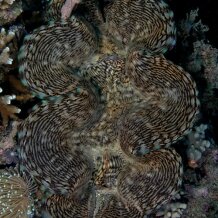Topic: Pinhole eyes in Nautilus and giant clam
The pinhole eye has evolved not only in the Pearly Nautilus, but also in another group of molluscs, the bivalves and specifically the giant clams (Tridacna).
Pinhole eyes in Nautilus
 The cephalopods are justly celebrated for their convergence of the camera eye with such groups as the vertebrates, and also the annelids. However, the Pearly Nautilus, which is generally regarded as an evolutionary relic (although its similarity to the extinct ammonites is relatively superficial as they belong to a different group of cephalopods) is more unusual because the light is focused through a pinhole aperture and there is no lens (in fact seawater can readily enter the eye). In some quarters the absence of a lens has been regarded as rather surprising, but why this should be so is not clear. Certainly the pinhole arrangement means that a precise focus is not possible, but the pinhole itself is capable of slow contraction and dilation and so is close to a pupil. In addition, the complexity of the retina is comparable to the octopus and although this has been regarded as an evolutionary “spandrel” and results from the nature of the original epithelium from which the retina is derived, it may well be that the nautilus has a better visual ability than thought. It is also worth remembering that the animals live in deep water, at daytime swimming at c. 300 m so there is very little light, and ascending to 90 m at night. In addition, they have considerable powers of olfaction, using the so-called rhinophores.
The cephalopods are justly celebrated for their convergence of the camera eye with such groups as the vertebrates, and also the annelids. However, the Pearly Nautilus, which is generally regarded as an evolutionary relic (although its similarity to the extinct ammonites is relatively superficial as they belong to a different group of cephalopods) is more unusual because the light is focused through a pinhole aperture and there is no lens (in fact seawater can readily enter the eye). In some quarters the absence of a lens has been regarded as rather surprising, but why this should be so is not clear. Certainly the pinhole arrangement means that a precise focus is not possible, but the pinhole itself is capable of slow contraction and dilation and so is close to a pupil. In addition, the complexity of the retina is comparable to the octopus and although this has been regarded as an evolutionary “spandrel” and results from the nature of the original epithelium from which the retina is derived, it may well be that the nautilus has a better visual ability than thought. It is also worth remembering that the animals live in deep water, at daytime swimming at c. 300 m so there is very little light, and ascending to 90 m at night. In addition, they have considerable powers of olfaction, using the so-called rhinophores.
Pinhole eyes in Tridacna (giant clam)
 Interestingly the pinhole eye has evolved not only in the Pearly Nautilus, but also in another group of molluscs, the bivalves and specifically the giant clams (Tridacna). In a large individual the eyes can number thousands and they are arrayed along the mantle margin. Why so many? The answer lies in the fact that the mantle tissue house numbers of symbiotic algae (dinoflagellates) known as zooxanthellae and these require, of course, access to sunlight for photosynthesis. Exposed mantle flesh is, of course, a natural target for predators, so the eyes provide an early warning system that can detect both shadow and movement. As has been pointed out there is little point in the eyes being visually too acute as they would then be triggering closure of the shell for every little disturbance.
Interestingly the pinhole eye has evolved not only in the Pearly Nautilus, but also in another group of molluscs, the bivalves and specifically the giant clams (Tridacna). In a large individual the eyes can number thousands and they are arrayed along the mantle margin. Why so many? The answer lies in the fact that the mantle tissue house numbers of symbiotic algae (dinoflagellates) known as zooxanthellae and these require, of course, access to sunlight for photosynthesis. Exposed mantle flesh is, of course, a natural target for predators, so the eyes provide an early warning system that can detect both shadow and movement. As has been pointed out there is little point in the eyes being visually too acute as they would then be triggering closure of the shell for every little disturbance.
Cite this web page
Map of Life - "Pinhole eyes in Nautilus and giant clam"
https://mapoflife.org/topics/topic_288_Pin-hole-eyes-in-Nautilus-and-giant-clam/
May 09, 2013
(Topic created 11th February 2008) | Last modified: 13th September 2010
Please note: words or phrases shown in bold in the PRINT VERSION of this text normally indicate hyperlinks on the webpage. These generally return a list of search results based on that keyword.